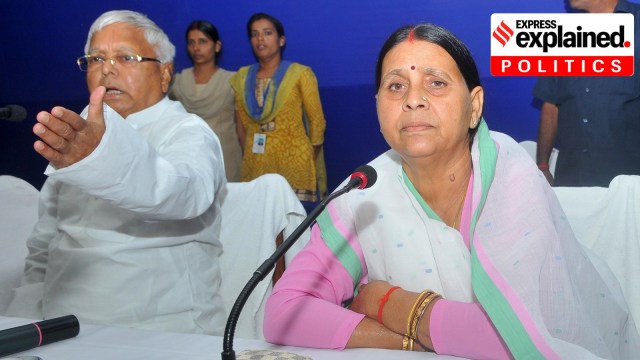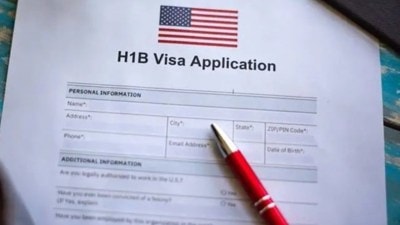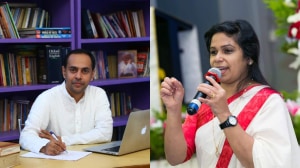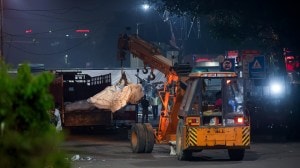Shyamlal Yadav is one of the pioneers of the effective use of RTI for investigative reporting. He is a member of the Investigative Team. His reporting on polluted rivers, foreign travel of public servants, MPs appointing relatives as assistants, fake journals, LIC’s lapsed policies, Honorary doctorates conferred to politicians and officials, Bank officials putting their own money into Jan Dhan accounts and more has made a huge impact. He is member of the International Consortium of Investigative Journalists (ICIJ). He has been part of global investigations like Paradise Papers, Fincen Files, Pandora Papers, Uber Files and Hidden Treasures. After his investigation in March 2023 the Metropolitan Museum of Art, New York returned 16 antiquities to India. Besides investigative work, he keeps writing on social and political issues. ... Read More
Bihar Chief Ministers | From homemaker to three-time chief minister – the rise of Rabri Devi
On July 25, 1997, facing imminent arrest in the fodder scam, Bihar Chief Minister Lalu Prasad Yadav announced that his wife Rabri Devi would be the next chief minister. For Rabri, it was a tectonic shift.
 Rabri Devi alongside her husband and RJD chief Lalu Prasad in 2015. (Express archives)
Rabri Devi alongside her husband and RJD chief Lalu Prasad in 2015. (Express archives)Bihar boasts one of the most fascinating political histories in India. With Assembly polls underway in the state, The Indian Express brings a series of articles tracing Bihar’s politics through the tenure of its 23 chief ministers. This article tells the story of Rabri Devi, Bihar’s 21st CM. You can click here to read about her predecessor, Lalu Prasad, and click here to read about her successor, Nitish Kumar.
On July 25, 1997, facing imminent arrest in the fodder scam, Bihar Chief Minister Lalu Prasad Yadav played his trump card. After an impromptu meeting at his residence with MLAs of his Rashtriya Janata Dal (RJD), he made an announcement that surprised many – he declared his wife Rabri Devi, a homemaker and political greenhorn with no legislative or leadership experience, as his successor.
The move was a masterstroke. It ensured that despite the transition, the seat of power – the chief minister’s official residence at Patna’s 1 Anne Marg – remained within the family and allowed Lalu to retain his influence in governance and politics.
For Rabri Devi, it was a tectonic shift and thrust her into politics. A chief minister for three terms, from 1997 to 2005, Rabri’s tenure was as unexpected as it was controversial.
The first and only woman chief minister — and the last of undivided Bihar — her tenure was, on the surface, a symbol of empowerment for backward-class women in the state. Yet, for the “accidental chief minister”, even that achievement was overshadowed by corruption charges and, above all, the tag of a “rubber stamp”.
The huddle – and the masterstroke
In the late 1990s, the fodder scam, a corruption scandal involving the embezzlement of about Rs 940 crore in Bihar, implicated several high-profile politicians and bureaucrats, including two ex-CMs, Lalu Prasad and Jagannath Mishra.
As the CBI investigation gathered steam, pressure mounted on Lalu to resign, with factions within his own Janata Dal and allies in the United Front (UF) government under I K Gujral demanding his exit.
With speculation rife that the Centre might dismiss his government and impose President’s Rule, Lalu, now on choppy waters, orchestrated a political masterstroke. On July 5, 1997, he split from the Janata Dal to form the Rashtriya Janata Dal (RJD), consolidating his loyalists under a new banner. Then, on July 15, 1997, to affirm his legislative strength, he moved a Motion of Confidence in the Bihar Assembly, securing all 167 votes from his MLAs in the then 324-member House.
Meanwhile, pressure mounted outside, with UF allies such as Tamil Nadu Chief Minister M. Karunanidhi and Congress president Sitaram Kesri urging him to resign.
On July 24, 1997, amid this pressure, the Supreme Court granted a stay on an arrest warrant issued by a CBI-designated court in Ranchi – a development that gave him time to plan his next move.
And that’s what he did. On July 25, 1997, RJD MLAs huddled at Lalu’s residence in Patna. That afternoon, Lalu proposed a resolution declaring his wife Rabri Devi as the new leader of the RJD legislature party. All the MLAs present there signed the document, and Lalu then proceeded to the Governor’s office to submit his resignation.
Hours later, Rabri Devi was sworn in as chief minister by Bihar Governor A.R. Kidwai.
The ‘accidental’ chief minister
Born to Sib Prasad Chaudhary and Maharjia Devi in Salar Kalan in Gopalganj district in 1955, Rabri Devi is one of seven children. Her brothers Sadhu and Subhash Yadav have both been active in politics.
Rabri married Lalu in 1973, and the couple went on to have nine children – including former deputy Bihar chief minister Tejashwi Yadav and politician and Rajya Sabha MP Misa Bharti.
In 1974 – months after their wedding – Lalu, a popular leader of the JP movement, was sent to jail. He would be arrested again during the Emergency and spend 15 months in prison. The arrests meant more responsibilities for Rabri, then in her 20s, especially when their first-born daughter Misa Bharti, named after the Maintenance of Internal Security Act (MISA), was born in 1976.’
In 1997, when Lalu was arrested, Rabri Devi once again took over from her husband, reluctantly at first and later more decisively, even fielding difficult interview questions. Throughout it all, she relied heavily on her husband’s trusted advisors to navigate choppy waters.
However, Lalu Prasad’s shadow continued to loom large, first when she was charge-sheeted along with her husband in a disproportionate assets case in 2000 and later when she faced criticism of being a puppet in her husband’s hands.
There were other challenges too. On February 11, 1999 – amid ongoing scam probes – President K R Narayanan, on the recommendation of the Atal Bihari Vajpayee government at the Centre, dismissed the Rabri Devi government citing a “breakdown of law and order” and imposed President’s Rule.
Public and parliamentary uproar ensued, with RJD allies protesting the move as politically motivated. Within a month, on March 9, 1999, Rabri was reinstated.
Bihar’s Assembly elections in early 2000 marked a resurgence for the RJD, which secured 124 seats in the 324-member House, emerging as the single largest party. However, it was Nitish Kumar, an NDA ally whose Samata Party was later rebranded as Janata Dal (United), who was sworn in as chief minister on March 3, 2000.
That reign, however, was short-lived. Within days, Nitish Kumar – whose NDA alliance, with 101 seats, was well short of a majority – brought a Motion of Confidence to prove his numbers but resigned on March 10 even before voting. A day later, Rabri Devi returned to office, remaining there until the Assembly’s term ended on March 6, 2005.
The 2005 elections, held twice due to hung verdicts, proved pivotal. A significant territorial change also preceded them: in the months to come, the southern region of Bihar would be bifurcated to form the new state of Jharkhand, reducing Bihar’s Assembly seats from 324 to 243 and altering electoral demographics.
In the February 2005 polls, the RJD emerged as the single largest party with 75 seats. However, the JD(U) with 55 seats and the Bharatiya Janata Party (BJP) with 37 formed an alliance and, along with other parties and independents, staked claim, ending the Lalu-Rabri era in power. However, no coalition got a majority and President’s Rule was imposed on March 7, 2005.
The October 2005 elections further sealed the shift: JD(U) won 88 seats, BJP 55, and RJD slumped to 54, relegating it to third place. Nitish Kumar’s alliance secured a clear mandate and took oath once again.
Today, Rabri Devi serves as a Member of the Legislative Council (MLC) and Leader of Opposition in Bihar’s upper house. Lalu and Rabri’s son, Tejashwi Yadav, leads the RJD’s Opposition efforts, striving to reclaim the family’s past glory amid ongoing legal battles and shifting alliances.



- 01
- 02
- 03
- 04
- 05




































